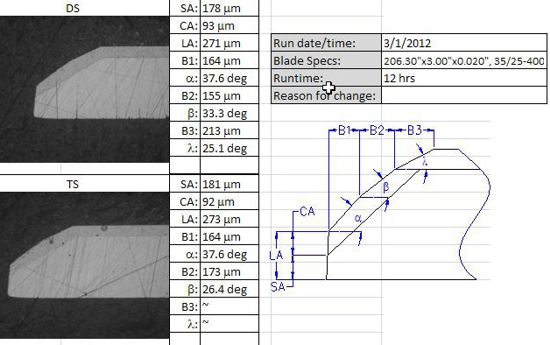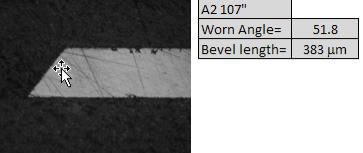Proper coater blade angle measurement, interpretation and setup
Jan 7, 2020
Measuring used coater blade wear angle is useful for determining where the coating station is set up on the blade bevel. A coater blade’s primary bevel angle can be ground as one straight surface from toe to heel. More and more popular nowadays is the grinding of a primary and a secondary angle. The benefits are that secondary angles provide more of an operating window for initial coat weight control and also reduce scratching and bleeding at the blade tip.
The objective of blade coating is to run slightly on the blade’s toe, with a gradual converging gap under the blade bevel. Riding too high on the toe results in scratching and poor coat weight appearance. Riding too high on the heel can cause wet bleeding and weeping at the blade tip.
Sheet smoothness is also affected by where the blade is positioned on the bevel. A good practice for optimizing sheet smoothness is to run some controlled trials moving the blade beam around and measuring the sheet smoothness. This is especially important when using extended wear blades such as tungsten carbide and ceramic based tips. Since the blade will not wear in, the beam angle has to be perfect right from the start in order to ride on the blade bevel correctly.

Ceramic blade tend and drive sides: 35°/ 25° compound bevel, worn angle 37.6°. Blade riding slightly on toe.
The images shown above are some blade analyses of a ceramic blade. Notice that this is a dual bevel blade. The primary angle is ground to 35° and the secondary angle is 25°. Very little wear is seen on this blade even after 12 hours of run time. The primary angle (alpha) is 37.6° so this blade was set up a couple of degrees above the initial bevel and riding slightly on its toe. From these photos you can also see the ceramic layer that is bonded to the steel blade below it.

Steel blade (for comparison)
The above image is of a steel blade original bevel 45°, worn angle 51.8°. Notice the sharp tip compared to the ceramic blade.
If you ever wish to discuss blade types, analysis and wear characteristics, contact your Valmet representative.